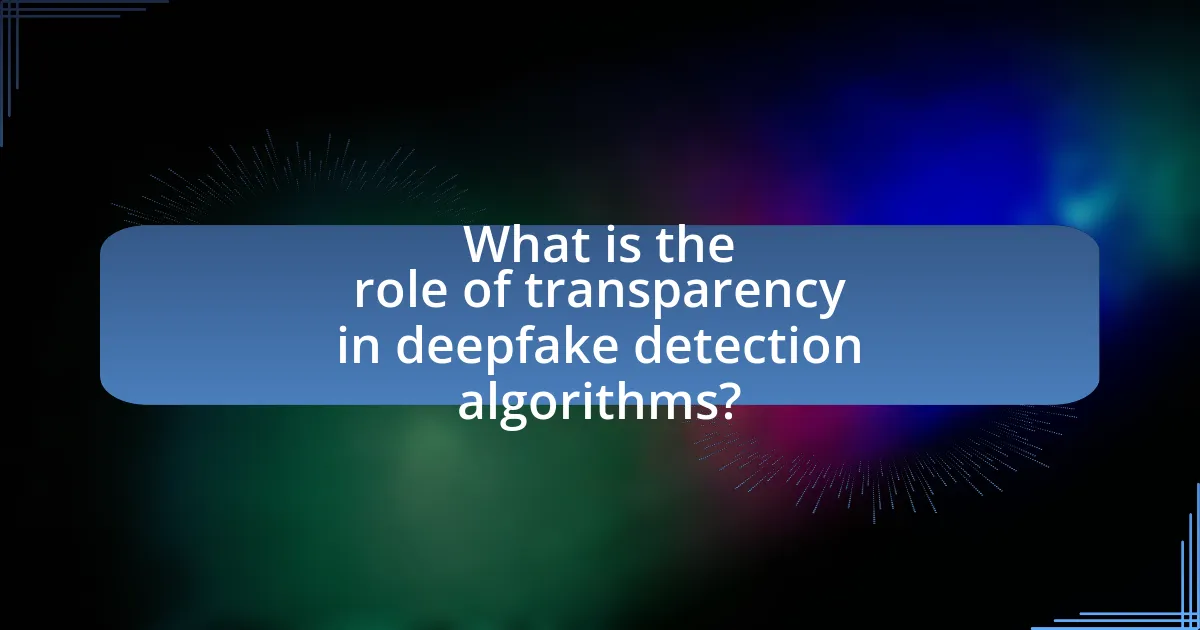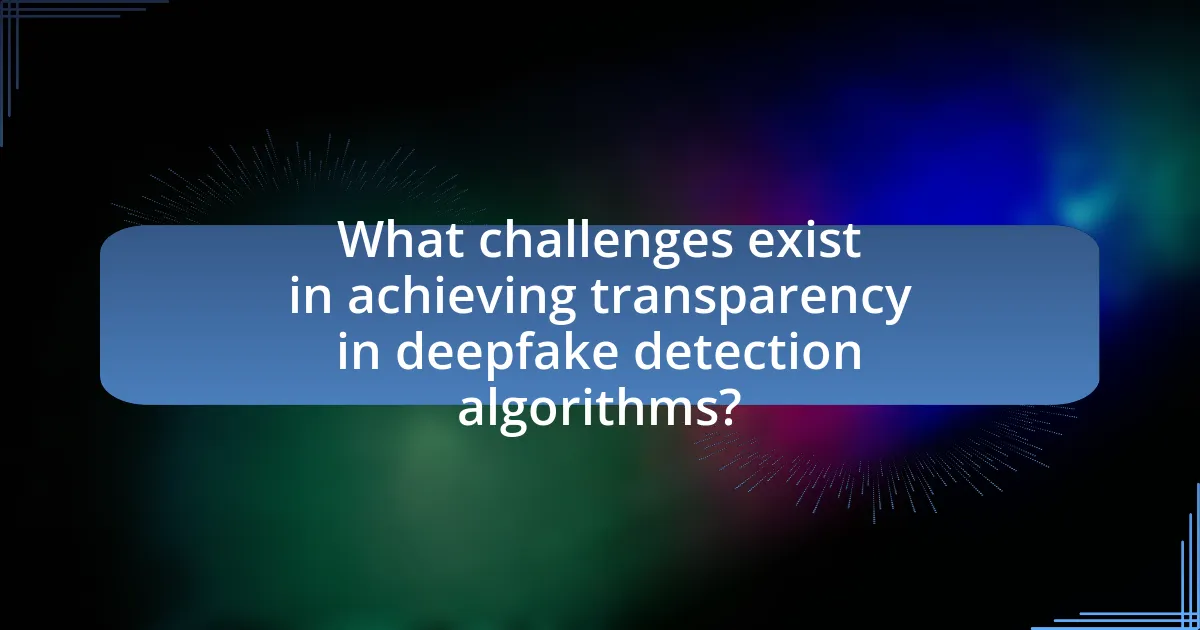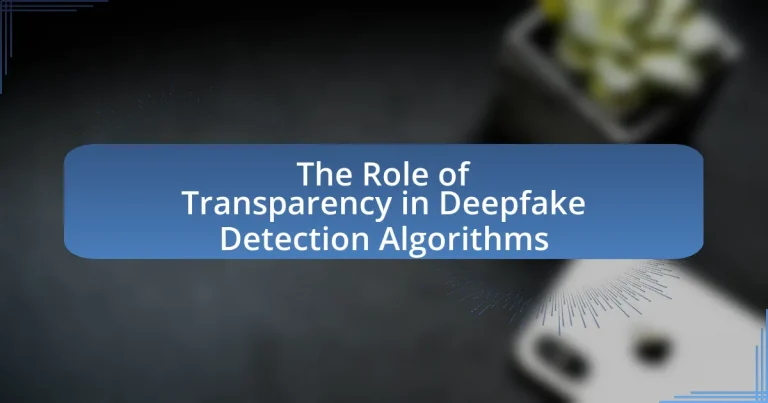The article focuses on the critical role of transparency in deepfake detection algorithms, emphasizing its importance for trust and accountability. It outlines how transparency enhances user confidence by providing insights into algorithmic processes, thereby facilitating independent verification and identification of biases. The discussion includes the ethical implications of transparency, the challenges faced in achieving it, and the technical barriers that hinder its implementation. Additionally, it highlights best practices for developers, the influence of regulatory frameworks, and future trends that may shape transparency standards in this evolving field.

What is the role of transparency in deepfake detection algorithms?
Transparency in deepfake detection algorithms is crucial for ensuring trust and accountability in their outcomes. By providing clear insights into how these algorithms function, including their methodologies and decision-making processes, stakeholders can better understand their effectiveness and limitations. Research indicates that transparency can enhance user confidence, as seen in studies where users are more likely to trust systems that openly disclose their operational mechanisms. Furthermore, transparent algorithms allow for easier identification of biases and errors, facilitating improvements and fostering collaboration among researchers and developers.
Why is transparency important in the context of deepfake detection?
Transparency is crucial in deepfake detection because it fosters trust in the algorithms used to identify manipulated content. When detection methods are transparent, users can understand how decisions are made, which enhances accountability and encourages the adoption of these technologies. For instance, studies have shown that transparent algorithms can lead to higher user confidence, as individuals are more likely to accept the results when they comprehend the underlying processes. Furthermore, transparency allows for independent verification and validation of detection methods, which is essential for maintaining the integrity of information in an era where deepfakes can easily mislead the public.
How does transparency enhance trust in detection algorithms?
Transparency enhances trust in detection algorithms by providing users with clear insights into how these algorithms operate and make decisions. When users understand the underlying processes, such as the data inputs, model architecture, and decision-making criteria, they are more likely to trust the outcomes produced by the algorithms. Research indicates that transparency can reduce perceived bias and increase accountability, as users can verify the fairness and reliability of the algorithm’s performance. For instance, a study published in the Journal of Artificial Intelligence Research highlights that transparent algorithms lead to higher user satisfaction and trust levels, as users feel more informed and empowered to assess the technology’s effectiveness.
What are the ethical implications of transparency in this field?
The ethical implications of transparency in deepfake detection algorithms include accountability, trust, and the potential for misuse. Transparency fosters accountability by allowing stakeholders to understand how algorithms make decisions, which is crucial in a field where misinformation can have serious consequences. For instance, a study by the Partnership on AI highlights that transparent algorithms can help build public trust, as users are more likely to accept technology when they understand its workings. However, transparency can also lead to misuse; if the inner workings of detection algorithms are disclosed, malicious actors may exploit this knowledge to create more convincing deepfakes. Thus, while transparency is essential for ethical practices, it must be balanced with the need to protect against potential abuses.
How does transparency affect the performance of deepfake detection algorithms?
Transparency enhances the performance of deepfake detection algorithms by providing clear insights into the data and methodologies used in their development. When algorithms are transparent, researchers and developers can better understand their strengths and weaknesses, leading to improved training processes and more effective detection techniques. For instance, studies have shown that algorithms trained on diverse and well-documented datasets perform better in identifying deepfakes, as transparency allows for the identification of biases and gaps in the training data. This understanding facilitates the refinement of detection models, ultimately increasing their accuracy and reliability in real-world applications.
What metrics are used to measure the effectiveness of transparency?
Metrics used to measure the effectiveness of transparency include user comprehension, trust levels, and decision-making outcomes. User comprehension assesses how well individuals understand the information provided, often evaluated through surveys or comprehension tests. Trust levels can be measured by analyzing user feedback and engagement metrics, indicating how much users rely on the transparency of the system. Decision-making outcomes are evaluated by examining the quality and accuracy of decisions made based on the transparent information, often supported by statistical analysis of decision results. These metrics collectively provide a comprehensive view of how transparency impacts user interaction and effectiveness in contexts like deepfake detection algorithms.
How can transparency lead to improvements in algorithm accuracy?
Transparency can lead to improvements in algorithm accuracy by enabling better understanding and evaluation of the algorithm’s decision-making processes. When developers and users have clear insights into how an algorithm operates, they can identify biases, errors, and areas for enhancement. For instance, a study by Lipton (2016) emphasizes that transparent models allow for easier debugging and validation, which can directly enhance performance metrics. Furthermore, transparency fosters collaboration among researchers, leading to shared best practices and collective advancements in algorithm design, ultimately resulting in more accurate deepfake detection systems.

What challenges exist in achieving transparency in deepfake detection algorithms?
Achieving transparency in deepfake detection algorithms faces significant challenges, primarily due to the complexity of the algorithms and the proprietary nature of many detection methods. The intricate architectures, such as deep neural networks, often operate as “black boxes,” making it difficult for users to understand how decisions are made. Additionally, many companies developing these algorithms do not disclose their methodologies, which hinders independent verification and trust. Research indicates that without clear documentation and open access to algorithmic processes, biases and inaccuracies may go unrecognized, leading to potential misuse or over-reliance on these technologies.
What are the technical barriers to implementing transparency?
The technical barriers to implementing transparency in deepfake detection algorithms include data privacy concerns, algorithmic complexity, and the lack of standardized metrics for evaluation. Data privacy concerns arise because revealing the inner workings of algorithms may expose sensitive information or proprietary techniques. Algorithmic complexity makes it challenging to provide clear explanations of how decisions are made, as many deepfake detection models operate as black boxes. Additionally, the absence of standardized metrics for evaluating transparency hinders the ability to compare different algorithms effectively, making it difficult to establish best practices. These barriers collectively impede the advancement of transparent and accountable deepfake detection systems.
How do data privacy concerns impact transparency efforts?
Data privacy concerns significantly hinder transparency efforts in deepfake detection algorithms. When organizations prioritize user privacy, they often limit the amount of data shared publicly, which restricts the transparency of the algorithms’ functioning and decision-making processes. For instance, regulations like the General Data Protection Regulation (GDPR) mandate strict data handling practices, compelling companies to anonymize or withhold data that could reveal algorithmic biases or inaccuracies. This lack of accessible data can prevent stakeholders from fully understanding how deepfake detection systems operate, ultimately undermining trust and accountability in these technologies.
What role does algorithm complexity play in transparency challenges?
Algorithm complexity significantly contributes to transparency challenges by making it difficult for users to understand how decisions are made within deepfake detection systems. Complex algorithms often involve intricate models, such as deep neural networks, which operate as “black boxes,” obscuring the rationale behind their outputs. This lack of interpretability can lead to mistrust among users and stakeholders, as they cannot ascertain the reliability or fairness of the algorithm’s decisions. Research indicates that as algorithmic complexity increases, the ability to explain and justify outcomes diminishes, further complicating efforts to ensure accountability and ethical use in applications like deepfake detection.
How do regulatory frameworks influence transparency in deepfake detection?
Regulatory frameworks significantly influence transparency in deepfake detection by establishing standards and guidelines that promote accountability and clarity in the technology’s use. These frameworks can mandate disclosure of deepfake content, requiring creators to label manipulated media, which enhances public awareness and trust. For instance, the European Union’s proposed Digital Services Act aims to regulate harmful content online, including deepfakes, thereby fostering an environment where detection technologies must adhere to transparency requirements. This regulatory oversight ensures that developers of deepfake detection algorithms are held accountable for their effectiveness and ethical implications, ultimately leading to improved public understanding and trust in the technology.
What regulations currently exist regarding transparency in AI technologies?
Regulations regarding transparency in AI technologies include the European Union’s General Data Protection Regulation (GDPR), which mandates that individuals have the right to understand how their data is processed, including the use of AI. Additionally, the EU’s proposed Artificial Intelligence Act aims to establish a legal framework for AI, emphasizing transparency, accountability, and risk management, particularly for high-risk AI systems. These regulations are designed to ensure that AI technologies operate in a manner that is understandable and accountable to users, thereby enhancing trust and safety in AI applications.
How can policymakers promote transparency in deepfake detection algorithms?
Policymakers can promote transparency in deepfake detection algorithms by mandating the disclosure of algorithmic processes and data sources used in their development. This requirement ensures that developers provide clear documentation on how algorithms function, the datasets they are trained on, and the criteria for accuracy and reliability. For instance, the European Union’s proposed AI Act emphasizes the need for transparency in high-risk AI systems, which includes deepfake detection technologies. By implementing such regulations, policymakers can foster accountability and trust, enabling users to understand the limitations and potential biases of these algorithms.

What best practices can enhance transparency in deepfake detection algorithms?
Best practices that can enhance transparency in deepfake detection algorithms include the implementation of open-source models, comprehensive documentation of algorithmic processes, and the establishment of standardized evaluation metrics. Open-source models allow for community scrutiny and improvement, fostering trust in the detection methods. Comprehensive documentation ensures that users understand how algorithms function, including their limitations and potential biases. Standardized evaluation metrics provide a consistent framework for assessing algorithm performance, enabling comparisons across different systems and promoting accountability. These practices collectively contribute to a more transparent and trustworthy deepfake detection landscape.
How can developers implement transparency in their algorithms?
Developers can implement transparency in their algorithms by providing clear documentation of the algorithm’s design, decision-making processes, and data sources. This includes detailing the training data used, the features considered, and the rationale behind the chosen model architecture. For instance, the use of explainable AI techniques, such as LIME or SHAP, can help elucidate how specific inputs influence outputs, thereby enhancing user understanding. Research indicates that transparency fosters trust and accountability, as seen in a study by Lipton (2016) in “The Mythos of Model Interpretability,” which emphasizes the importance of interpretability in machine learning systems.
What tools and frameworks support transparency in AI development?
Tools and frameworks that support transparency in AI development include TensorFlow, PyTorch, and the AI Fairness 360 toolkit. TensorFlow and PyTorch provide extensive documentation and community support, enabling developers to understand model architectures and training processes. The AI Fairness 360 toolkit, developed by IBM, offers metrics and algorithms to assess and mitigate bias, promoting fairness and transparency in AI systems. These tools facilitate reproducibility and accountability, essential for transparent AI practices.
How can user feedback be integrated to improve transparency?
User feedback can be integrated to improve transparency by systematically collecting and analyzing user insights regarding deepfake detection algorithms. This process allows developers to understand user concerns, preferences, and experiences, which can inform algorithm adjustments and enhance clarity about how detection mechanisms operate. For instance, incorporating user feedback can lead to the development of user-friendly interfaces that explain detection results and the rationale behind them, thereby fostering trust. Research indicates that transparency in algorithmic processes, supported by user input, can significantly increase user confidence and satisfaction, as evidenced by studies showing that users are more likely to trust systems that openly communicate their decision-making criteria.
What are the future trends regarding transparency in deepfake detection?
Future trends regarding transparency in deepfake detection include the development of open-source algorithms and standardized evaluation metrics. Open-source initiatives, such as the Deepfake Detection Challenge, promote collaboration and allow researchers to scrutinize and improve detection methods. Standardized metrics will enable consistent assessment of algorithm performance, fostering trust and accountability in the technology. Additionally, regulatory frameworks are likely to emerge, mandating transparency in the use of deepfake detection tools, which will further enhance public confidence in their effectiveness.
How might advancements in technology influence transparency practices?
Advancements in technology significantly enhance transparency practices by enabling real-time data sharing and improving the traceability of information. For instance, blockchain technology provides immutable records that can verify the authenticity of digital content, thereby increasing trust in deepfake detection algorithms. Additionally, machine learning algorithms can analyze vast datasets to identify patterns and anomalies, making it easier to disclose the origins and modifications of media. These technological improvements facilitate clearer communication about the processes and methodologies used in deepfake detection, ultimately fostering accountability and public confidence in the systems employed.
What role will public awareness play in shaping transparency standards?
Public awareness will significantly influence the development of transparency standards in deepfake detection algorithms. As the public becomes more informed about the implications of deepfakes, there will be increased demand for clear guidelines and accountability from technology developers. Research indicates that heightened public scrutiny can lead to more robust regulatory frameworks, as seen in the case of data privacy laws like the General Data Protection Regulation (GDPR), which emerged partly due to public concern over data misuse. This correlation suggests that as awareness grows, stakeholders will be pressured to adopt higher transparency standards to maintain trust and credibility in their technologies.
What practical steps can organizations take to ensure transparency in deepfake detection algorithms?
Organizations can ensure transparency in deepfake detection algorithms by implementing open-source practices, conducting regular audits, and providing clear documentation of their methodologies. Open-source practices allow external experts to review and validate the algorithms, fostering trust and collaboration. Regular audits by independent third parties can assess the effectiveness and fairness of the detection systems, ensuring they operate as intended. Additionally, clear documentation detailing the algorithm’s design, data sources, and decision-making processes enhances understanding and accountability, which is crucial for stakeholders. These steps collectively promote transparency and build confidence in the reliability of deepfake detection technologies.


